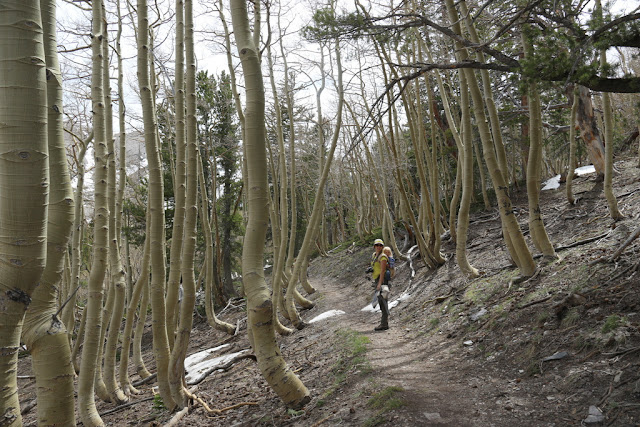Last summer, the Strawberry Creek fire burned over 4,000 acres in and near Great Basin National Park, including up by the Strawberry Creek trailhead. My first time to visit it this year was to accompany glacial researchers Ben Laabs and Jeff Munroe to map the glacial features in the watershed as part of their project to make a glacial map for the park. We found that the vegetation was coming back nicely near the trailhead.
We headed up towards the Osceola Ditch, wearing hard hats to protect us from snags (well, at least from smaller falling branches, a hard hat wouldn't do much for a big tree!). It was hard finding the trail. Soon we left it and hiked up much higher.
As we walked, they pointed out different clues that the past glaciers had left behind, like glacial striations on rocks (where softer rocks got scraped by the harder rocks embedded in the ice), different kinds of rocks that had been deposited, and shape of rocks. The glaciers in the Strawberry Creek watershed had previously been mapped by Piegat in his 1980 doctoral dissertation, but he was covering a lot of ground and couldn't spend as much time as they were. These glaciers had formed up by Bald Mountain (the snow-covered peak in the photo below). The researchers found that it was much easier to read the land after the fire, as they could see more rocks.
Sometimes we got off on a tangent, like looking at the rock spalling next to this burnt tree. Basically the fire was so hot here that it burned the rock, causing the outer layers of it to fall off. Part of reconstructing the glacial history can include doing cosmogenic beryllium dating of moraine boulders, or taking a small piece of a boulder and dating it. If parts of the boulder are flaking off, the technique doesn't work so well.
I found one of the helispots still flagged from the fire. It's not flagged anymore.
As we hiked up and down the moraine, we spotted this huge ponderosa pine that had been spared. There were plenty of white fir ladder fuels near its base (smaller white fir trees that could extend the fire up into the ponderosa pine), so it got lucky.
We saw evidence of past logging in the watershed and wondered why the big ponderosa had been spared.
We found lots of elk droppings and found these scratches on an aspen.
Here and there was evidence of the forest recovering, like the elderberry below.
But the steep hillsides have not recovered.
Meadow areas look much better, with an array of wildflowers and grasses.
And wet areas are also coming back well.
We reached a section of trees that had speckled bark. I later learned that this is likely due to three-toed woodpecker activity in the area. They'll pull off bark looking for insects.
As we hiked down the moraine, we found small depressions, called kettles. These are from ice melting out. The remarkable thing is that these were on a very old moraine, over 100,000 years old, but are well preserved.
A view of the Osceola Ditch, a ditch made over a hundred years ago to transport water from streams around the mountain to the mining town of Osceola. The ditch didn't last long due to construction problems, water thievery, and the small amount of water available.
We had nice views of the meadow down below, and the scientists wondered if a small rise on the other side might be another moraine.
So we went down to check it out, passing some nice basin wild-rye on the way.
When we got to the rise, they found some good indications that it was a moraine. This extended the reach of the Strawberry Creek glaciers much further than had previously been mapped.
From our vantage point looking east, we could look back to where we had just hiked and see that 100,000+ year-old moraine (marked 'Moraine' in the photo). It slopes down to meet the creek. The wet meadows in the middle of the photo would have been covered with a thin layer of ice and be where this part of the glacier had met its demise.
It was an interesting day to not only see how things were recovering from the fire, but to also learn more about how to discover clues in the landscape that showed what had happened there in the past. The results from this study should be ready in a few months, and I'll be sure to post a link.





































































